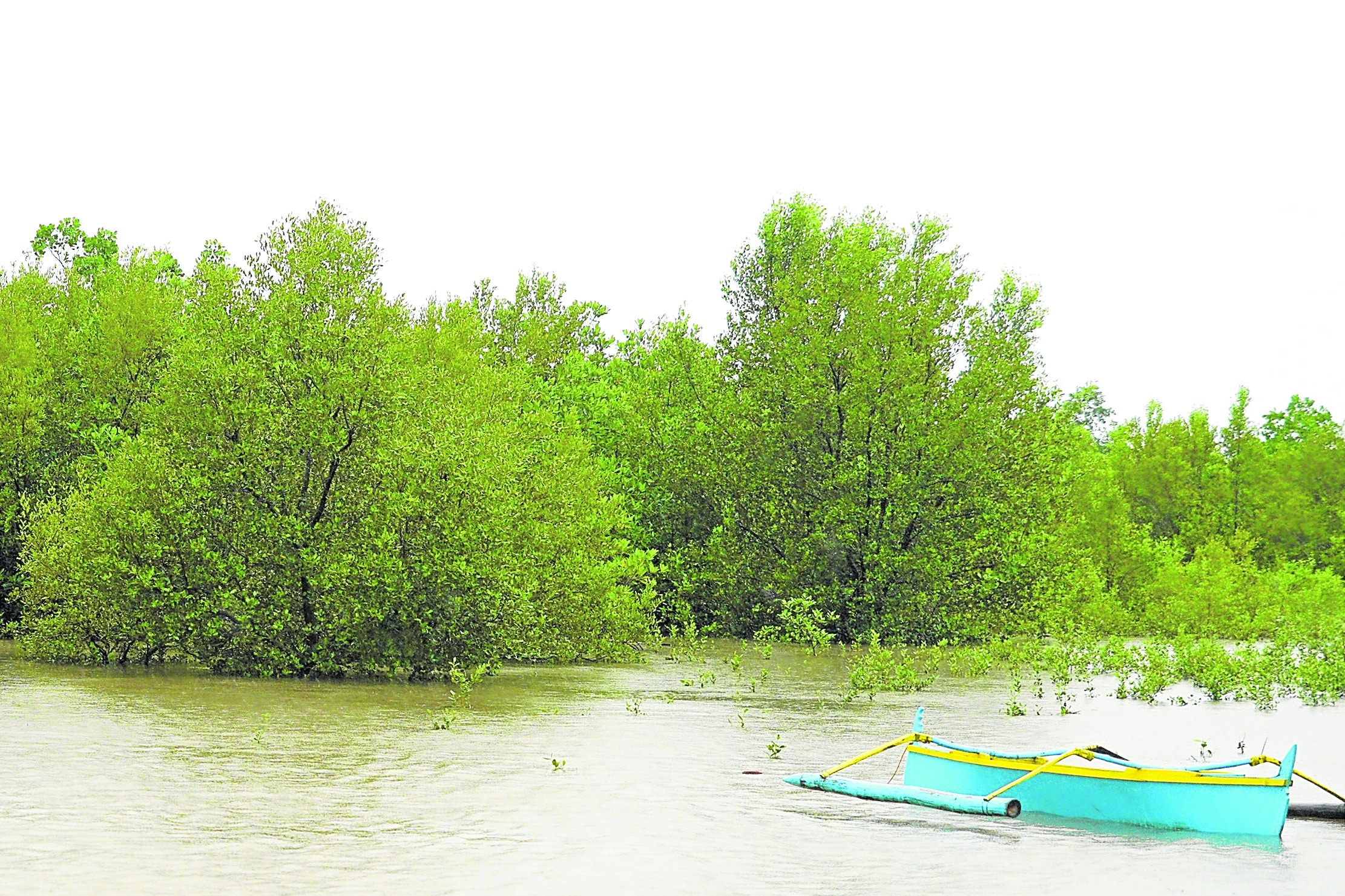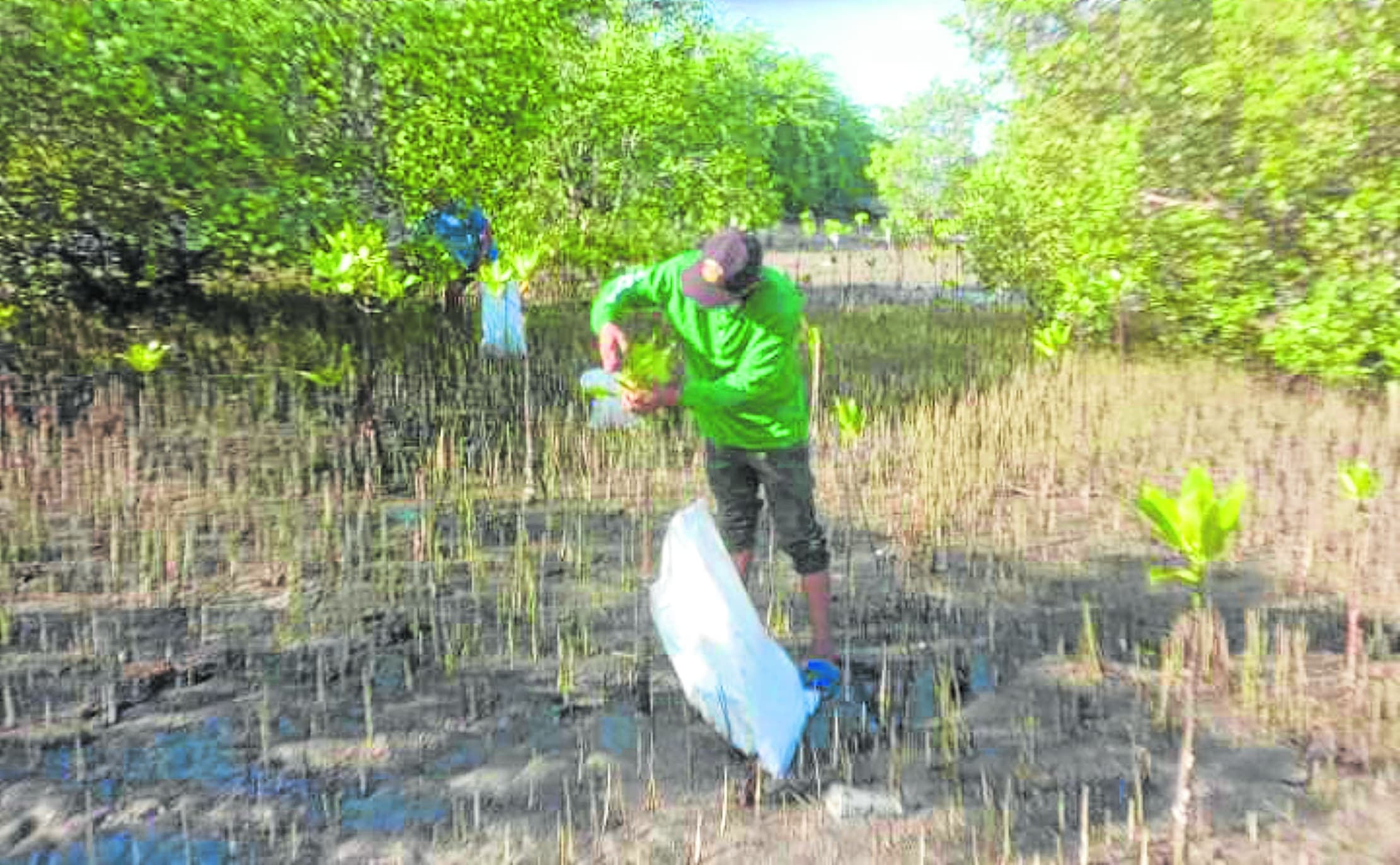
PROTECTION As Typhoon Enteng (Yagi) battered western Pangasinan in the first week of September, these mangrove trees along the coastline of Dasol acted like the town’s sentinels, their branches spread wide to absorb the heavy rain and strong wind and to protect communities from heavy flooding. —Ray Zambrano
DASOL, PANGASINAN, Philippines — A group of volunteers conducting a cleanup in this town’s mangrove forests on Sept. 24 was shocked to discover plastic water and tea bottles with foreign labels scattered throughout the protected area.
“We were puzzled as to how these bottles ended up inside the mangrove forests, which we’ve worked hard to protect and are off-limits to people except for cleanup and official activities,” municipal agriculturist Frieda Makinano told the Inquirer recently.
Out of the 80 sacks of trash collected, about 50 percent were plastic bottles and bags, likely used for fingerling culture in neighboring towns.
READ: Mangroves save lives: Greenbelt zones pushed in PH
This plastic waste threatens the town’s nearly 100-hectare virgin mangrove forest in Barangay Amalbalan and the 46-ha mangrove area in Malacapas village, nearly destroyed four decades ago but have since regrown through reforestation efforts.
“We’ve worked hard to restore our mangrove resources, but now it feels like we’re becoming a dumping ground for foreigners and fish cage operators from other towns,” Makinano lamented.

HARMFUL WASTE A volunteer removes a plastic sheet covering a young mangrove tree during a recent cleanup in the mangrove forests of Dasol. —Photo courtesy of Dasol Municipal Agriculture Office
Plastic waste poses a serious threat to the mangroves, suffocating young trees or uprooting those not yet fully anchored. If left unchecked, the young trees will die, endangering the entire forest.
Additionally, the plastic waste could harm the town’s commercial solar salt industry by contaminating Dasol Bay, which supplies saltwater for salt production.
Dasol, known for its salt production, has consistently rejected proposals for fish cage operations and mining activities in the area to protect the local salt industry. However, the influx of plastic waste threatens this important income-generating activity for its residents.
Dasol, situated in the western section of Pangasinan and home to more than 31,000 people, is composed of 18 barangays, nine of which are coastal and four are riverine villages where majority of the communities depend on Dasol Bay for livelihood.
Of the 13 barangays, four are mangrove areas. But only the villages of Amalbalan and Malacapas have embarked on mangrove rehabilitation projects.
Troubled history
The town’s mangrove forests have a long, troubled history.
In 1988, the centuries-old trees in Amalbalan were cut down to make way for fishponds, with the approval of local officials.
Residents, led by the late Pangasinan provincial administrator Rafael Baraan and former Mayor Ramon Lizeraldo, fought to protect the mangroves, taking their case to Malacañang and concerned government agencies.
Despite their efforts, the mangrove forests were decimated, and the community lost its rich fishing grounds.
FOREIGN TRASH Members of a cleanup team gather plastic bottles and bags from Dasol’s mangrove forests facing the West Philippine Sea. Among the waste materials they found were plastic water and tea bottles with foreign labels (right). —Photo courtesy of Dasol Municipal Agriculture Office
Most of the fishpond operations, however, did not last and eventually abandoned by their owners.
Without the mangroves to protect the area from waves, flooding became a frequent problem, damaging pond embankments and forcing many operators who were short of funds to give up.
In 2005, 17 years after the first mangrove tree was felled, reforestation efforts began with the planting of the first mangrove propagule.
This marked the start of the Multi-Partnership Mangrove Rehabilitation of Dasol Bay, a joint project involving the local government, environmental group Tanggol Kalikasan and Washington State University’s Office of International Research and Development.
The project replanted 6 ha, at a rate of 4,500 propagules per hectare. The propagules were sourced from Quezon province, including species such as “bakauan babae” (Sc. Rhizophora mucronata), “bakauan lalaki” (Sc. Rhizophora apiculata) and “bakauan bato” (Sc. Rhizophora stylosa).
Regular activity
Since then, replanting has become a regular activity, supported by the local government, the Department of Environment and Natural Resources, the Bureau of Fisheries and Aquatic Resources (BFAR) and private companies.
Rosario Segundina Gaerlan, BFAR Ilocos regional director, said her agency made sure to involve coastal fisherfolk in the mangrove rehabilitation in Malacapas.
By 2024, the area had largely recovered, resembling its original state as a dense mangrove forest.
“The area has transformed into what looks like an island due to land accumulation, and nature has backfilled the fishponds, which are now covered in mangroves,” Makinano said.
University researchers visiting the site were amazed by its regeneration.
The town continues to replant mangroves, although not all propagules are expected to survive. The mangrove forests are also being supplemented with other tree species like agoho, umbrella trees and coconuts.
Even cogon grass has started to thrive in the area.
To protect these efforts, the local government has converted 67 ha of the Amalbalan forest and nearly 50 ha in Malacapas into the Dasol Mangrove Conservation and Eco-Park.
While the Malacapas mangroves were not converted into fishponds, preserving some old-growth trees, the eco-park has faced setbacks, including damage to its view deck and bamboo boardwalk from recent typhoons.
Despite these challenges, the park remains guarded, with poaching and the collection of crabs and shellfish strictly prohibited.
However, the town is once again fighting for the survival of its mangroves, this time against the growing threat of plastic waste.

